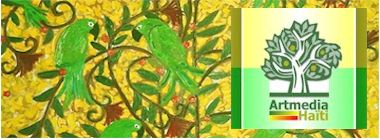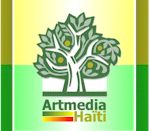
|
|
|
| --> Category: A History of Haitian Art - Discover Haiti |
| |
|
|
| The Saint-Soleil experiment of the 1970s involved the distribution of art materials to a group of peasants who have never painted to see what would come out. |
|
A History of Haitian Art Without a doubt, Haitian Art, especially in the areas of painting and sculpture, has received worldwide critical acclaim while at the same time enjoying some measure of commercial success. Yet, that success comes with a history of controversy, as Haitian artists, local and western critics have dueled over what form of artistic expression is more authentic and therefore worthy of acclaim. Even the origins of some Haitian Artistic movements were disputed. The Beginnings While most books on Haitian Arts choose to begin their story with the Centre d'Art and 1944, there is clear evidence of artistic activity dating back to the Pre-Columbian era. The Tainos would make dolls, drawings, signs (maybe the ancestors of the veve) that represented their deities, while archeologists also found sculptures and pots of many kinds that were wonderfully crafted. There exists a record of a former slave called Luc, from Leogane, who, during colonial times earned a reputation as a painter. In the days after Independence, both Henri Christophe and Alexandre Petion were patrons of the arts.They regularly entertained European artists, and some art schools were founded at the time. In the 1840s, the Emperor Soulouque founded an Imperial Academy of the Arts. In Christophe's court, foreign and local artists alike found ample commission work. The main themes were the glory of the Revolution or the Royal family itself. One of those artists was Numa Desroches (1802-1880) who produced one of the most intriguing paintings of that period. It is a view of Palais Sans Souci with a spatial distribution that reminds one of the naïve paintings of the 20th Century. Further evidence of artistic activity comes from a photograph dated from c. 1900 that shows a shack adorned with religious paintings. Again the style of the paintings is close to the Primitive Art that would become popular in the 1940s. Both paintings show that naïve art is a long tradition in Haiti instead of the creation of any Art School. The early part of the 20th Century sees a giant emerging from the northern town of Cap-Haitien. He was Philome Obin. Obin was a self-taught painter whose main themes were scenes of every day life in Cap-Haitien and historic scenes of the Haitian Revolution. In many ways, his work is representative of the spirit of the 20s and 30s when the global negritude movement found an echo in Haiti with the Indigenist movement. Indigenism and Modernism Indigenism meant returning to our African roots and finding new aesthetic values and a natural cultural identity. One of the first painters to respond to the call of the indigenist movement was Petion Savain. His style was realist and simple. Of the artist who were to follow his style we could note Georges Ramponneau. Cuban and Caribbean influence were to give rise to the Modernist movement. Modernism was most mostly espoused by the elite. Modernist painters of note included Luce Turnier (1924-1994), Lucien Price (1915-1963) etc. They tried to adapt modern artistic theories to the local environment in the manner of a Wilfredo Lam, the Cuban master. The Naive Art movement and the Centre d'Art Shortly later, in the 1940s, Dewitt Peters, an American school teacher founded the Centre d'Art in Port-au-Prince Haiti. The Centre d'Art became the champion of the art form that would be known as -Naïve Art- , especially with the arrival of co-director Selden Rodman. Selden Rodman, a proponent of McCarthyism, rejected modernism as being too post-war, too vanguard and therefore too socially inclined. Calling the brand of Art these untrained and uninfluenced painters practiced as naive or primitive is generally taken as being pejorative; the term intuitive is the more correct and more accepted qualifier for the art form. The spatial composition and proportions of these artists did not abide by any of the laws of modern aesthetics, but rather revealed spontaneity, freedom of expression and freshness. Contrarily to what many manuals wrote, though, neither the Centre d'Art nor Dewitt Peters invented Naïve Art, but mainly brought it to the attention of the Western World. Haitians did not learn how to paint out of the blue, but rather showed influence of traditions that go way back. The primitives of the first generation received worldwide acclaim. Critics and collectors received that movement as -authentic- and -unspoiled- . The main heroes of that movement were otherwise common, non artistically trained folk who had great talent. They were Hector Hippolyte, Castera Bazile (1923-66), Wilson Bigaud (b. 1931) and Rigaud Benoit. Vaudou was prominently featured in the works of those artists. The cornerstone piece of the Primitive Art School has to be the mural project of the Cathedral of Sainte Trinite. For that mural, Obin, Benoit, Bazile and Bigaud placed traditional religious motifs like the Ascension of Christ in a very Haitian context. Characters were painted with black faces, while drums and sacrificial animals were featured in a few of the paintings. The Primitive Movement was accompanied with great controversy. Many Other Haitian artists, the intelligentsia and the elite resented the cachet of authenticity given to Naïve Art. Why would only unschooled artists be recognized as authentic Haitian artists? In earnest what gives Western critics the right to decide what represents true Haitian Art? What gives the Centre d'Art the right to act as arbitrator, championning one movement versus the other? Well, for better or for worse, Primitive Art and its champion, the Centre d'Art, became a driving force behind the Haitian Art Industry as a whole by getting worldwide attention towards the small nation. For one the Centre d'Art gave a chance to painters who otherwise would never be noticed by the conservative Art establishment of the time. It allowed vaudou artists like Hector Hippolyte and Andre Pierre to express themselves, and made religious art more acceptable. It provided support and a market for generations of painters and made international celebrities out of many. Intuitive Art became very prized by tourists who kept alive a whole industry, although the quality of the artwork would become questionable. Therein lies the great irony. With Haitian Art, success is often a double-edge sword. Whenever an art form gets some kind of critical recognition, foreign demand and foreign backing would automatically increase. In turn, artists who many times worked for galleries would get specific demands and feedback, that in many ways would slant their production. -Do more market scenes- , or -landscapes are very hot now- . They would be compelled to mass-produce art work in line with what is popular, instead of what they were inspired to do. Before long, many copycats and wannabes would emerge and ultimately, the whole movement would turn into commercialism, with decreasing freshness, originality and quality of production. Aftermath of the Naive Movement There were many offshoots to the Naïve movement. Philome Obin would create the School of Cap-Haitien that would see artists such as Seneque Obin. Second generation painters include Gerard Valcin (1925-88), Wilmino Domond, Seymour Bottex, Gabriel Alix, and Prefete Duffaut (b. 1923), famous for his mountainous landscapes where Heaven meets Earth and the laws of Gravity are nonexistent. He also founded the School of Jacmel. The Poto Mitan (central pole in a hounfor, a vaudou temple)School of 1968 shows renewed interest in Vaudou and Pre-Hispanic themes. It featured Tiga(Jean-Claude Garoute (b. 1935) and Patrick Vilaire (b. 1942). The Saint-Soleil experiment of the 1970s involved the distribution of art materials to a group of peasants who have never painted to see what would come out. The major artists produced by that experiment include Prospere Pierre Louis(1947-96), Levoy Exil(b. 1944) and Stevenson Magloire. That experiment figured prominently in Andre Malraux-s last book l-Intemporal. There were also many counteractions to Naïve Art. One of them, Modernism wanted to adapt more established painting styles to the local settings. In the 50s, many artists like Lucien Price and Dieudonné Cédor broke away from the Centre d'Art and founded the -Foyer Des Arts Plastiques- . However, the movement lacked focus and soon waned. One of the few commercially successful reactions to Intuitive Art was the School of Beauty, with Bernard Sejourne, Jean Rene Jerome(1942-91), Philippe Dodard, and Emilcar Similien. Their style was of a dreamy surrealism, where the individual was featured instead of the group; where the individual-s feelings and thoughts received focus instead of the national consciousness. The School of beauty soon lapsed into rich ornamental luxury and commercialism as soon as success came to its members. The Others A few painters are worth mentionning although they do not seem to fit any category. We have Bernard Wah, who on the other extreme of the School of beauty displayed a quasi-mechanical approach to his characters approaching the macabre or the fantastic. Another is Lyonel Laurenceau, master of the knife painting technique whose portraits of simple folk were popular from the late 70s to today. Herve Thelemaque achieved notoriety in France, while Claude Dambreville excelled with his high contrast, flat color scenes of women at the market..Let us mention a few masters of iron work: Georges Liautaud who started out by making funeral crosses in the town of Croix des Bouquets, Serges Jolimeau, who achieved worldwide notoriety, John Sylvestre, and the Louis Juste brothers all from Croix des Bouquets. Sculptors of note include Albert Mangones who produced the famous Marron Inconnu- statue in Port-au-Prince. Let us also salute a great artist of haitian descent whose fame in the 80s was as brilliant as it was short lived: Jean Michel Basquiat, a quintessential modern artist whose work was part Andy Warhol, part Brooklyn ghetto. Finally, what of the present? The artistic production of Haitians has never been more alive with many branches existing now, with so many Haitians living in the diaspora. The young artists show great promise, while some of the old masters show extra life. But let us end by mentioning some of the accomplished artists of this generation: Henri Dubreuil, Ernst Louis Jean, Ernst Louizor, Valmidor... Just to name a few. A History of Haitian Art by Discover Haiti http://www.discoverhaiti.com [email protected] |
|
|
||
 Designed and Maintained by InterMedia, The Internet Communications Network of Haiti™  ArtMediaHaïti Suite 200 - Angles des Rues Grégoire et Chavannes P.O. Box 16042 - Pétionville, Haiti Telephone: (509) 511-1314, 557-5290, 403-1130, 401-1626 - Fax: (626) 608-3594 http://www.artmediahaiti.com [email protected] |
||
| Service | Contact | Cart-Panier | Home-Accueil | ||
| © All Rights Reserved-Copyright©2001-2002 by ArtMedia Haiti-Port-au-Prince, Haiti | ||
